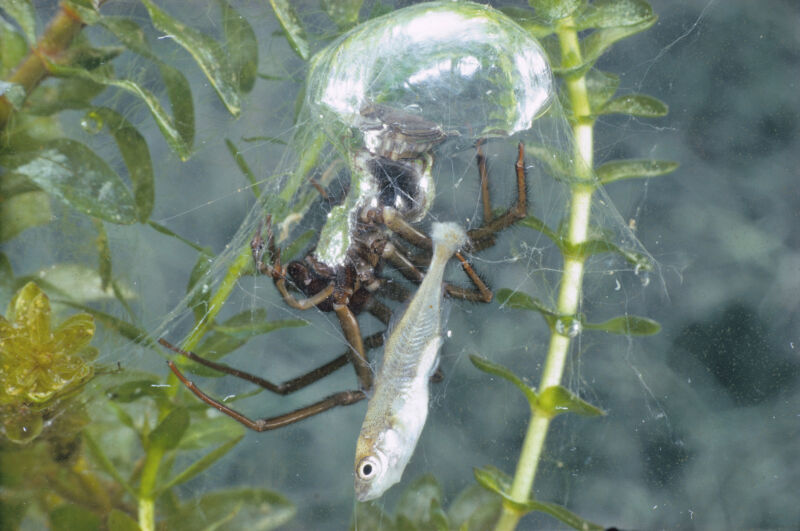Spider (He is our hero) —
Some make nests inside seashells, others tote bubbles of air on their backs.

Enlarge / Of all the aquatic spiders, the diving bell spider is the only one known to survive almost entirely underwater, using bubbles of air it brings down from the surface.
Shrubbery, toolsheds, basements—these are places one might expect to find spiders. But what about the beach? Or in a stream? Some spiders make their homes near or, more rarely, in water: tucking into the base of kelp stalks, spinning watertight cocoons in ponds or lakes, hiding under pebbles at the seaside or creek bank.
“Spiders are surprisingly adaptable, which is one of the reasons they can inhabit this environment,” says Ximena Nelson, a behavioral biologist at the University of Canterbury in Christchurch, New Zealand.
Finding aquatic or semiaquatic spiders is difficult work, Nelson says: She and a student have spent four years chasing a jumping spider known as Marpissa marina around the pebbly seaside beaches it likes, but too often, as soon as they manage to find one it disappears again under rocks. And sadly, some aquatic spiders may disappear altogether before they come to scientists’ attention, as their watery habitats shrivel due to climate change and other human activities.
What scientists do know is that dozens of described spider species spend at least some of their time in or near the water, and more are almost surely awaiting discovery, says Sarah Crews, an arachnologist at the California Academy of Sciences in San Francisco. It also appears that spiders evolved aquatic preferences on several distinct occasions during the history of this arthropod order. Crews and colleagues surveyed spiders and reported in 2019 that 21 taxonomic families include semiaquatic species, suggesting that the evolutionary event occurred multiple independent times. Only a swashbuckling few—not even 0.3 percent of described spider species—are seashore spiders; many more have been found near fresh water, says Nelson.
It’s not clear what would induce successful land-dwelling critters to move to watery habitats. Spiders, as a group, probably evolved about 400 million years ago from chunkier creatures that had recently left the water. These arthropods lacked the skinny waist sported by modern spiders. Presumably, the spiders that later returned to a life aquatic were strongly drawn by something to eat there, or driven by unsafe conditions on land, says Geerat Vermeij, a paleobiologist and professor emeritus at the University of California, Davis — because water would have presented major survival challenges.
“Since they depend on air so much, they are severely limited in whether they can do anything at all when they are submerged, other than just toughing it out,” says Vermeij. Newly aquatic spiders would have had to compete with predators better adapted to watery conditions, such as crustaceans, with competition particularly fierce in the oceans, Vermeij says. And if water floods a spider’s air circulation system, it will die, so adaptations were obviously needed.
